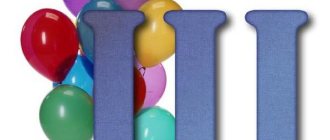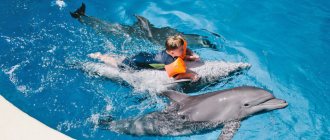Quite often, parents complain that children encounter problems pronouncing sounds that are difficult for them. As a rule, the greatest difficulty for them is hissing sounds; in particular, parents’ questions are related to how to teach a child to correctly pronounce the letters “s”, “k” and others. You need to pay attention to developing this skill in childhood.
The sound C is problematic in pronunciation
Despite the fact that most parents seek speech therapy help most often when the child is already 5 years old, most pediatricians agree that work on sound pronunciation should begin much earlier.
This will prevent the incorrect pronunciation of the sound from taking hold. To carry out such activities it is not at all necessary to have special skills - it is enough to learn only a few simple techniques.
Tips for pronouncing the C sound
What is composition?
Composition is the art of arranging objects in a frame. In fact, there are shapes and proportions that people find pleasing, but the film itself also has to tell a story. The placement of your subjects and actors in the frame can add meaning to your story by highlighting some elements and leaving others in the background. In a big-budget Hollywood film, the director has an assistant who handles the composition of the shot. In small budget films, the director often performs both functions.
“Framing and editing define the path where the viewer's eye looks. It may not be too much of an exaggeration to say that the director really controls the viewer's attention." — Alexander Mackendrick “On Cinema”
If you do everything right, then absolutely every frame of your film can be taken and hung in a frame on the gallery wall. It's a tough task, and few people succeed at it without a lot of time, big budgets, great editors and patient investors. Your budget and time constraints may prevent you from doing this, but there are things you can do from the start to make sure your film looks the best it can.
Video lessons from a speech therapist
Dear parents!
I bring to your attention links to speech therapy video lessons that will help you in your homework with your child.
| Production of the sound R (part 1) by imitation | |
| Production of the sound R (part 2) from D | |
| Setting the sound R (part 3) from Z | |
| Setting the sound P (part 4) from lower vibration | |
| Setting the sound L | |
| Production of sound Ш (part 1) | |
| Staging the sound Ш (part 2) | |
| Setting sounds S, Z (part 1) | |
| Setting sounds S, Z (part 2) | |
| Setting the sounds Ch, Shch | |
Articulatory gymnastics for hissing sounds.
| “Kneading the dough” | |
| "Parachute" | |
| "Jam" | |
| "Swing" | |
| “Chatterbox” | |
| "Cup" | |
| "Painter" |
Articulatory gymnastics for whistling sounds.
| "Frog" | |
| “Fence” | |
| “Tube” | |
| "Painter" | |
| “Kneading the dough” | |
| “Brushing our teeth” | |
| "Cat" |
Articulatory gymnastics for the sound L.
| “ Pancake” | |
| "Swing" | |
| “ Chatterbox” | |
| "Cup" | |
| "Painter" | |
| “Kneading the dough” | |
| “ Delicious jam” |
Articulatory gymnastics for the sound R.
| "Window" | |
| "Swing" | |
| “Horse” | |
| "Fungus" | |
| "Harmonic" | |
| “Kneading the dough” | |
| "Painter" | |
| "Woodpecker" | |
| “Start the engine” | |
| Production of the R sound from “Chatterbox” | |
| Setting the sound R from the exercise “Mushroom” | https://www.youtube.com/watch?v=j5-_dMcF1NA&feature=iv&src_vid=MG8EX8-iTng&annotation_id=annotation_635117271 |
I wish you success!!!
Movement of frames... movement.
Another obvious thing that affects the composition of a film's frame is that things not only move in it, but sometimes through it, and often the camera itself moves. This means a lot of rehearsals. Actors moving across the set must pass through their cues at extremely precise timing, and your camera operator must accommodate the movement across the set and the movement in the frame while maintaining the pleasing placement that drives the story.
The rules—or rather, guidelines—of composition apply to film, painting, and still images.
What does this mean? That you can read a book about still image composition and use it as the basis for your film composition? Absolutely. The rules—or rather, guidelines—of composition apply to film, painting, and still images.
See also: What is HEVC and why is it needed?
How to properly conduct speech therapy sessions with a child? Tips and tricks for parents
How to teach a child to speak sibilants, including the letter s? Any parent can provide simple speech therapy assistance to a child. However, the success of the events will largely depend on how correctly they are carried out.
If the child does not have complex speech disorders and can pronounce most sounds, home correctional classes with a parent will be quite enough to bring sound pronunciation back to normal. In this case, correct sound production will be achieved through automation of pronunciation.
Speech therapy classes should be started sooner
Exercises to develop sound pronunciation skills are useful not only for children who have certain speech problems, but also for completely healthy ones, due to the fact that they perfectly develop the articulatory apparatus, making it more mobile and flexible.
If a child has more serious problems with sound pronunciation, and in speech he makes a large number of grammatical errors, solving the problem on his own is still quite risky. And the sooner parents turn to a speech therapist for help in solving a problem, the more benefits it will bring to the child. And the easier it will be to teach him how to pronounce sounds and speak correctly.
Rule of thirds
If you take just one thing away from this article, it would have to be the rule of thirds. This is the basic rule of composition. Divide the screen into thirds horizontally and vertically, like in a game of tic-tac-toe, and then your key objects should fall at the intersection of two of these lines. Some filmmakers adhere to this rule more than others, but it is very difficult to find a film that does not use this rule.
We said earlier that people are vertical and movie screens are horizontal - this means that in order to get a framed person, you either need to make them very small or crop them. Both of these methods are perfectly acceptable. Let's take a look at Ridley Scott's Blade Runner. In this close-up of Harrison Ford, Scott and Cinematographer Jordan Cronenweth decided to cut him off at the shoulders and top of his head so that the actor's gaze would be at the intersection of the top horizontal line and the right vertical line of our imaginary frame.
Unlike the real world, in cinematic and photographic composition, you can chop off the top of someone's head with impunity. This does not apply to people's chins - the chins should remain in the frame unless you cut off an equal portion of the top of the head.
Articulation gymnastics and its features
As a rule, difficulties in pronouncing the sound “s” are associated with insufficient mobility of the organs of the articulatory apparatus. This must be done with the help of specially organized gymnastics. What is the best way to conduct classes?
Articulation exercise in front of a mirror
- A strict sequence of exercises and regularity are the main principles that ensure the effectiveness of exercises for the speech organs. It is best to use ready-made sets of exercises that teach you to pronounce certain sounds. They are selected taking into account the age and other characteristics of the child.
- In order for the child to participate more willingly in the lesson, it is best to teach him to speak in a playful way, supplementing him with interesting riddles for the desired letter, songs, nursery rhymes and jokes
- Do not overload your child with exercises. It is better to do no more than 2-3 in one lesson, but with multiple repetitions - this makes it easier to teach the child new things.
- New exercises starting with the letter “c” can be introduced only after the child has already thoroughly mastered all the previous ones and copes with them without much effort.
- In order for the child to have the opportunity to see and correctly understand the technique of the exercises proposed to him and pronounce sounds, it is best to use a mirror for practice.
- When performing exercises, it is important to monitor the symmetry of the child’s face, the accuracy and smoothness of movements, and the correct pace. Without this, the effectiveness of the exercises will be minimized.
Lessons on pronunciation of the sound C
Helpful advice: Before you start articulatory gymnastics, you need to do several exercises in order to “warm up” the speech organs: a simple smile, stretching the lips in a tube or ring, lifting the tongue will prepare them well for the exercises and will improve the results of your student.
After this, you can begin the articulatory gymnastics itself (in this case, we will consider the complex of Fomicheva M.V.). Such exercises should teach a child correct sound pronunciation.
List of exercises for whistling sounds
"Put the ball into the goal"
The exercise teaches the child to direct a stream of air and pronounce hissing sounds. An improvised “gate” made of cubes is installed on the table. The child’s task is to push a cotton ball (“ball”) into them, stretching his lips forward and directing a stream of air towards it. It is important that the child does not puff out his cheeks, and that the action is performed in one step.
"Naughty Tongue"
The exercise allows you to relax your tongue and also form a directed air flow. The child puts his tongue on his lower lip and, keeping his mouth slightly open, says “five-five-five.” It is important that the lip on which the tongue rests does not tuck, and that the air stream flows as smoothly as possible, without interruptions.
Naughty tongue - game description
Wide tongue
The wide edge of the tongue is placed on the lower lip and held in this position for up to 5-10 seconds. The organs of the articulatory apparatus should be as relaxed as possible, and the smile should be free of tension.
Advice for parents: Be patient and try to treat these activities as a fun game.
Remember that your baby is improving, this is something new for him, something he is doing for the first time in his life. Try to understand that for him this involves serious effort, and the more interesting this activity is for him, the greater your chances of a quick result.
Poems and riddles starting with the letter C for repetition
Articulatory gymnastics exercises that teach how to pronounce sounds are quite complex and unusual for a child.
That is why you should not expect him to complete them the first time and completely without errors. In order to teach a child to speak correctly, you need to think through a lesson-game plan. And in case of failure, you should not scold him - it is better to support him and offer to try again. Over time, the child will learn both the letter and its corresponding sound. leave a comment
Eyes are an important thing.
We look at people's eyes. We instinctively look at how other people look. We have a deep belief that the person inside the body is accessible through the eyes - and this is universal. When your cat or your dog wants to communicate with you, they look at your eyes, and they don't read any books on psychology. When you frame a shot, if the eyes are in focus, then you can sacrifice a lot of other things that are out of focus.
See also: Do you know what chromakey is? Learn the secrets of working with chromakey in 5 minutes
In this Raiders of the Lost Ark shot, Harrison Ford returns, with the actor completely obscured, only visible in silhouette except for his right eye, which looks out with a wariness that, along with his distinctive hat, brings personality into the frame. And of course, by “random coincidence” the eye also ends up at the intersection of imaginary lines. Also notice the sloppy white areas on the left and right, they serve to balance the frame. “Frame balance?” You ask.
How is work on sound pronunciation organized?
- First, you need to find out which speech organs are involved in the pronunciation of sounds that cause problems in the child. You will need to work on them first of all with the help of articulatory gymnastics for one or another letter.
- Stage of direct sound production.
- The stage of sound amplification and its learning in special speech therapy poems, texts, songs, etc.
Phonetic exercises for the sound C
Let's take a closer look at how to teach a child to pronounce the letter c easily and freely.
Balance and symmetry
Think of your frame as a shadow field in which you place objects, and which is strictly in the center. Balancing the left and right sides usually gives a feeling of harmony, while an unbalanced frame creates tension. If you go against the rule of thirds, sometimes a completely symmetrical frame, with the main subject in the center, can be used extremely effectively. Some directors are slaves to symmetry and when used correctly this technique can be extremely powerful. One of the most exciting proponents of symmetry was Stanley Kubrick, who abandoned the rule of thirds and replaced it with an obsessive commitment to central framing and symmetry, giving us incredibly powerful images that depict order so perfect that it becomes somewhat menacing.
In this example from Pulp Fiction, we have Bruce Willis on the left side of the screen, but the frame is balanced by license plates. You'll notice the same thing in both shots from Blade Runner.
See also: 5 tips on how to get high-quality color when shooting with any camera.
Sound setting [C]
Olga Dolganova
Sound setting [C]
Setting the sound "C"
Lesson 1
Breathing exercises
"Harmonic"
. I. p. - stand straight, lower your arms. Place your palms on your tummy and take a deep breath through your nose. Hold your breath for 1-2 seconds. Exhale through your mouth.
Exercises for lips and facial muscles
Game exercises
"Smile"
.
“We are glad to meet a friend
. Stretch your lips in a smile to the limit and hold them in a tense position for some time. The teeth are closed. Repeat 3-4 times.
"Creepy Monkeys"
.
Movements with closed lips to the right and left. (In case of difficulty, help with your index fingers.)
Development of phonemic awareness
Isolation of the sound [s] against the background of syllables and words among sounds that are distant in acoustic and articulatory characteristics.
Game "Catch the Sound "
.
The child should clap his hands when he hears the sound [s] . First, the teacher pronounces the sounds [l] , [s], [r] [s], [l], [m], [b], [s], then the syllables la, so, ro, su, pa, su, sy , ba. If a child identifies a sound from a sound or syllabic series , the words mak, cheese, bough, shelf, son, bun, lamp, catfish are given.
Development of the voice and switchability of the organs of the articulatory apparatus
Pronunciation of vowel sounds with changes in the strength and pitch of the voice.
"Let's sing a lullaby to the doll"
: ah-ah-ah-ah-ah-ah-ah.
"Teeth hurt"
: ooo
"Steam Hoot"
: uh-uh.
Lesson 2
Breathing exercises.
Development of exhalation force.
Blowing through a tube. Blowing soap bubbles. Comparison of expiratory duration. Pronouncing the sound [f] (long exhalation, pronouncing the sound [t] (short exhalation)
.
Developing the correct direction of the air stream along the midline of the tongue
Blow a paper snowflake off your palm. Whose snowflake will fly farther?
Exercises for lips and facial muscles
"We are having fun"
.
"Smile"
. The lips are in a smile, the teeth are brought together to 2 mm.
"Sponges swing on a swing"
. Teeth and lips are clenched. Alternately lift the corners of your mouth with the help of your fingers.
“Sleep, little peephole, sleep, other one. The right eye sleeps - wakes up. The left eye sleeps and wakes up.” Alternately opening and closing the eyes.
Tongue exercises
"The tongue is tanning"
.
Place your tongue on the bottom of your mouth. “The tongue dived to the bottom of the river
.
“Let's see where the little tongue lives
. Lowering the tongue to the bottom of the mouth.
“The tongue fits through the crack of the door”
. Biting the tongue with teeth from tip to middle and vice versa.
"Monkey Tease"
. Place your wide tongue on your lower lip and pronounce the syllable pya-pya-pya-pya-pya.
Development of the voice and switchability of the organs of the articulatory apparatus.
"Conversation between the dogs Barbosa and Pushka"
. Pronouncing syllable combinations pa-ba, py-by, po-bo, pu-bu in a whisper, quietly and loudly.
Development of phonemic awareness
Isolating the sound [s] among sounds that are similar in acoustic and articulatory characteristics. Sounds : [s], [z], [s], [sh], [ts], [s]. Syllables: sa, for, so, sha, tso, su, zy, sy. The words dog, bunny, sun, fur coat, boots, garden, etc. The child raises his hand or claps his hands if he hears the sound [s] .
Lesson 3
Breathing exercises.
Development of exhalation force
"Put out the candle"
. Developing an intense intermittent exhalation while pronouncing fuuuuu.
Developing the correct direction of the air stream along the midline of the tongue
"The Storm Howls"
. Bring a bottle with a narrow neck to your lower lip and blow. If noise appears at the same time, it means that the air stream is directed correctly.
Exercises for lips and facial muscles
“The monkey is smiling, and the baby elephant is ready to drink some water.”
.
Lips in a smile (hold for a count of 5-6)
.
Alternating positions - lips in a smile and “tube”
.
“My teeth hurt on the right side. Teeth hurt on the left side"
. Alternately raising the corners of the mouth while simultaneously closing the corresponding eye.
Tongue exercises
"Raindrops are knocking on the roof"
. Bite your wide tongue with your teeth and pronounce the syllables ta-ta-ta-ta-ta-ta.
"Shovel"
. Place a wide tongue on the lower lip so that the side edges of the tongue touch the corners of the mouth. The language is calm, not tense. If the tongue does not relax, suggest squeezing your lips tightly, then stretch them into a smile and push your tongue between them.
Exercises to develop the ability to form a bow with the lateral edges of the tongue with the upper molars
“The baby learns to pronounce the sound [i] ”
.
Place the tip of your tongue behind your lower teeth and pronounce the sound [i] . Make sure that the dimple
in the tongue is exactly in the middle.
"Donkey's Song"
.
Pronouncing the sound combination ia .
"Boat"
.
Stick your tongue out of your mouth and fold it into a boat ( “groove”
). If the exercise does not work, you can place a thin stick or probe on the middle part of the tongue.
"Fungus"
.
I will collect different mushrooms in a basket - russula, moss mushroom, etc. Sucking the tongue to the roof of the mouth. (Recommended for use when correcting lateral sigmatism.)
Development of switchability of the organs of the articulatory apparatus and coordinated work of the lips and tongue
Pronouncing the vowels i-yu, yu-ya, i-e, e-ya; i-i-e; and-i-e-yu.
Development of phonemic awareness
Isolating the sound [s] from words . Find toys whose names contain the sound [s] , from a number of others (owl, fox, bear, dog, baby elephant, car, giraffe, donkey)
.
Determining the position of the sound [s] in the words owl , baby elephant, forest, nose.
Lesson 4
Breathing exercises
Development of exhalation force
Developing the correct direction of the air stream along the center line
"The sled went down the hill"
.
Smile, lower the tip of your tongue behind your lower teeth, raise your back in a “mound” manner
. Exhale.
Developing a long, strong exhalation while pronouncing the sound combinations iffffff , iffffff for a long time.
Lip exercises
Lips in a smile (count to 10)
.
"The boat rocks on the waves"
.
Alternately lifting the corners of the mouth up (with and without the help of hands)
.
Tongue exercises
“The tongue is sick and lies in bed ”
.
Open your mouth wide and cough (the tongue involuntarily drops to the bottom of the mouth)
.
Place the tongue in a “path”
on the bottom of the mouth so that a small tongue appears.
(Hold in this position for as long as possible.)
“Teases”
.Put your wide tongue on your lower lip and say: bya-bya-bya-bya-bya, pya-pya-pya-pya-pya-pya
(with a change in intonation)
.
Grooved tongue
inside the mouth.
Note. If the exercise does not work, use a bottle with a narrow neck. When you blow into a bubble, a round gap involuntarily appears in your tongue.
"Funny Clowns"
.
Arching of the back of the tongue upward while the tip rests on the gums of the lower incisors. Pronouncing the sound combination i-hee-hee .
Development of switchability of the organs of the articulatory apparatus
“The tongue swings on a swing”
.
Pronouncing the syllables ya-la, ya-la, ya-la, gradually increasing their number in one exhalation.
Development of phonemic awareness
Distinguishing between words that sound similar: bear - bowl, caska - porridge, cheese - ball, salt - naughty (based on pictures)
.
Finding pictures that have the sound [s] on the topics “Vegetables”
and
"Fruits"
.
Lesson 5
Development of exhalation force
Developing the correct direction of the air stream along the midline of the tongue. "The wind shakes the leaf"
. Lips in a smile, teeth open. Blowing on a protruding tongue lying on the lower lip.
Lip exercises
“The hippopotamus has his mouth open, the hippopotamus is asking for rolls”
.
Smile. On the count of “one,”
clench your lips tightly, and on the count of
“two,”
open your mouth wide.
Tongue exercises
Arching of the back of the tongue upward while the tip rests on the gums of the lower incisors. Pronounce i, hee, ee.
Raising and lowering the middle part of the tongue (the back of the tongue with the tip of the tongue lowered at the lower gums.
"Boat"
. Raise the side edges of the tongue until you have a depression in the middle of the tongue.
"Cheerful Children"
.
The starting position is the same. Pronounce the sound combinations ihi-hi , ihi-hi, ihi-hi.
Development of switchability of the organs of the articulatory apparatus and development of coordinated work of the lips and tongue
"Alien Conversation"
.
Pronouncing the syllables ti-ti-ti, cha-cha-cha, te-te-te (with a change in stress and intonation)
.
Development of phonemic awareness and simple types of phonemic analysis
— Is there a sound [s] in the words cabbage, beets, radishes, beans, lettuce, garlic?
- Find vegetables whose names contain the sound [s] . Where is the sound [s] heard in the word salat ? In the word garlic? In the word cabbage?
Development of logical thinking
Game "Fifth Odd"
. Cabbage, beets, potatoes, radishes, apricots. Set aside the extra picture.
Lesson 6
Development of exhalation force
Developing the correct direction of the air stream along the midline of the tongue
Smile. Lower the tip of the tongue behind the lower teeth, raise the back in a “mound”
, exhale.
Lip exercises
Raising and lowering of the upper lip exposing the upper teeth.
Alternate raising and lowering of the corners of the mouth.
Tongue exercises
Grooved tongue
keep the outside of the mouth motionless, and then open the lips widely, then touch
the “groove”
.
Game "I am not me"
.
The speech therapist pronounces phrases, and the children answer: “Me too.”
or
“Not me
.
For example, a speech therapist says: “I love chocolate.”
And the children answer:
“And I, and I, and I.
”
“I like to chew a cup.”
Children:
“Not me, not me, not me
.
Development of switchability of the organs of the articulatory apparatus and development of coordinated work of the lips and tongue
Pronouncing syllable combinations pti-pti-pti, pty-pty-pty; petit-pt, petit-pt; pt-pt-pt-pt-pt.
Development of phonemic awareness
"Pick and name"
.
Place pictures in two piles depicting objects whose names contain the sounds [s] and [w] .
Determine the position of the sound [s] in the words sled , boots, owl, bus.
Sound setting [s]
The position of the organs of the articulatory apparatus when pronouncing the sound correctly [s]
The teeth are brought together and are at a distance of 1 mm. The lips are stretched as if smiling. The tongue rests on the lower incisors, a “groove”
, through which a stream of exhaled air flows.
The sound [s] is dull , pronounced without the participation of the voice.
Techniques for sound production [s]
Auditory perception of sound . Creating an auditory image of sound
Gaming techniques. "Whistles"
.
"Snowstorm"
.
Formation of a visual image of sound
Showing the articulatory position of a sound on a dummy or articulation diagram. Articulation profile display.
Formation of a kinesthetic image of sound (sensation of the position of the organs of articulation)
Showing the position of the organs of articulation using the fingers. Clenched fingers of the right hand (imitation of tongue)
lower to the base of the fingers of the left hand
(as if they were the lower teeth)
. Description of the position of the organs of articulation.
Open your mouth. Lower the tip of the tongue towards the lower incisors so that a gap forms in the middle of the tongue. Exhale forcefully and evenly. should be [s] .
Leading lines
We follow lines like roads. Leading lines are usually imaginary lines that move from one object to another to draw our attention from the main object of focus to a secondary one. Going back to Ridley Scott's Blade Runner, we have a perfect example of leading lines, and this time they actually are lines. The railing directs our attention directly to the people on the left side of the screen. Note also the strong use of the rule of thirds and the post in the foreground to ensure balance.
Depth of field
The camera can highlight what's important and take focus away from other things that aren't as important. This is done using depth of field - the area of the frame that is in focus. Depth of field can either be deep, meaning everything is in focus - like Kubrick's image from 2001 - or it can be shallow, meaning little is in focus - like shots from Harrison Ford's Blade Runner and Raiders from the Lost Ark." Also note that in the close-up Ford in "Blade Runner" he uses the focus in the background to balance the frame.









